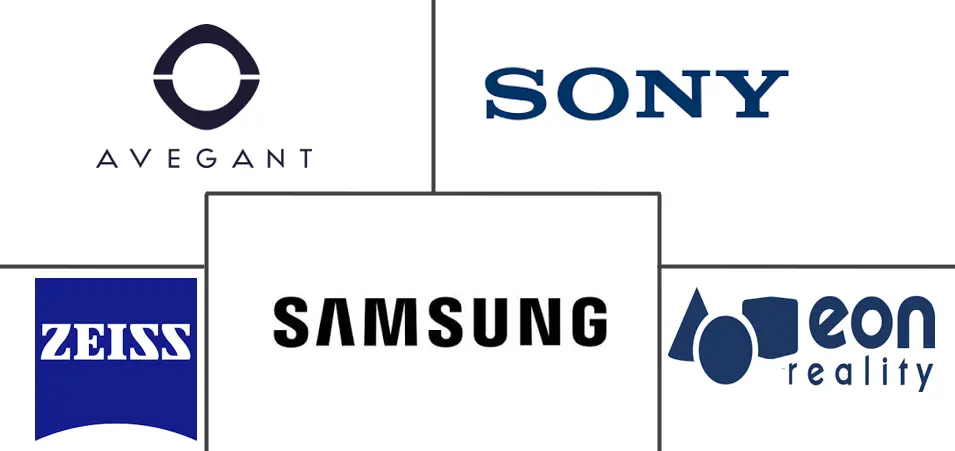Immersive Virtual Reality Market Size and Share
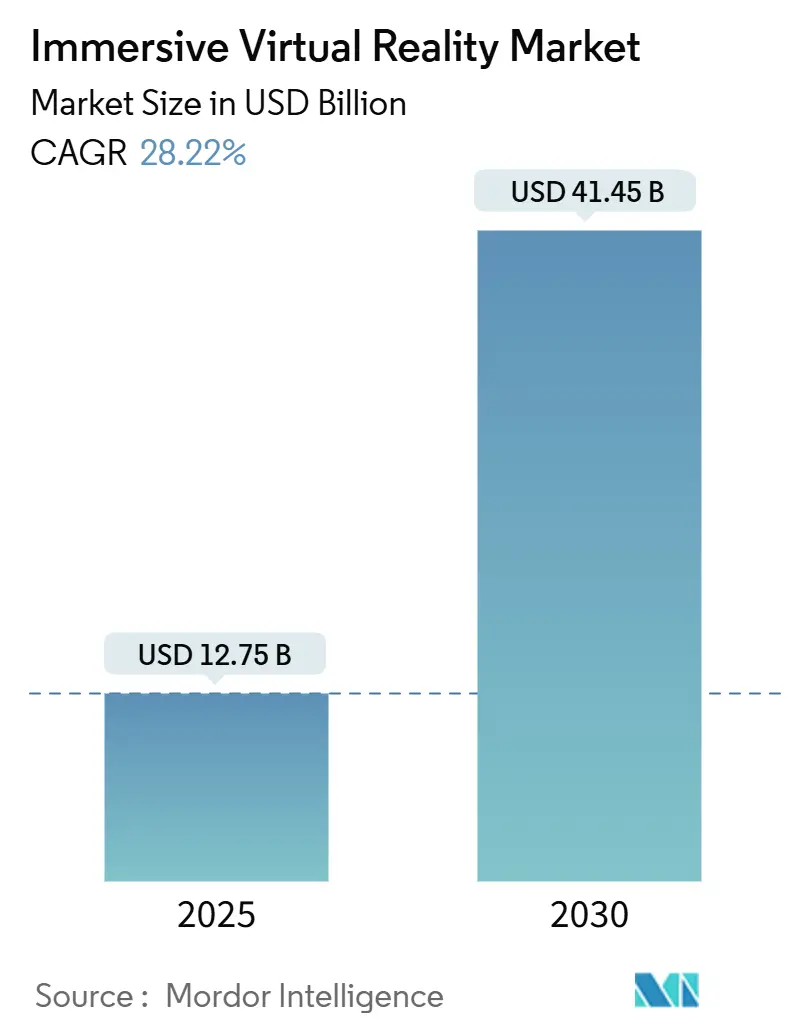
Immersive Virtual Reality Market Analysis by Mordor Intelligence
The Immersive Virtual Reality Market size is estimated at USD 12.75 billion in 2025, and is expected to reach USD 41.45 billion by 2030, at a CAGR of 28.22% during the forecast period (2025-2030).
Commercial demand is expanding as enterprises shift from pilot programs to scaled roll-outs, particularly in aerospace flight simulation, defense pilot training, and regulated healthcare therapies. Head-mounted displays remain the dominant device form factor, yet stand-alone models are accelerating fastest as buyers value untethered set-ups that remove PC or console requirements. North America retains spending leadership, but Asia Pacific is growing more quickly on the back of Chinese government standardization initiatives and more than 100 large-scale VR installations launched in 2024. Momentum is also evident in enterprise ROI metrics, Walmart compressed training times by 96% and Boeing trimmed wiring-process instruction by 75% confirming cost savings that extend well beyond entertainment. Supply-side turbulence in semiconductors and high-purity quartz is lifting component costs, though software-delivered advances such as cloud streaming and AI-driven adaptive content help mitigate hardware price friction.
Key Report Takeaways
- By device, head-mounted displays captured 86% of immersive virtual reality market share in 2024, while stand-alone HMDs are forecast to grow at 33.20% CAGR to 2030.
- By end-user industry, entertainment and gaming held 46% revenue share in 2024; healthcare applications are positioned to expand at a 29.42% CAGR through 2030.
- By component, hardware held 86% revenue share in 2024; the software component is positioned to expand at a 29% CAGR through 2030.
- By immersion type, fully-immersive systems commanded a 62% share in 2024 and are projected to rise at a 31.34% CAGR to 2030.
- By geography, North America accounted for 38% of the immersive virtual reality market size in 2024, whereas Asia Pacific is set to advance at 32.60% CAGR over the same period.
Global Immersive Virtual Reality Market Trends and Insights
Drivers Impact Analysis
| Driver | (~) % Impact on CAGR Forecast | Geographic Relevance | Impact Timeline |
|---|---|---|---|
| Use of VR in aerospace and defence training | +4.80% | Global, concentrated in North America and Europe | Medium term (2-4 years) |
| Consumer adoption via gaming HMDs | +6.20% | Global, led by North America and Asia Pacific | Short term (≤ 2 years) |
| Government-funded VR healthcare therapy pilots | +3.50% | North America and Europe, expanding to Asia Pacific | Long term (≥ 4 years) |
| Enterprise metaverse platforms for remote collaboration | +5.10% | Global, enterprise-focused regions | Medium term (2-4 years) |
| Source: Mordor Intelligence | |||
Use of VR in Aerospace and Defence Training
Defense agencies are embedding immersive simulators into core curricula. The U.S. Air Force deployed 225 VR devices under its Pilot Training Transformation initiative, while Mass Virtual secured USD 67 million in related contracts. Lockheed Martin and Red 6 integrated augmented overlays for the TF-50 trainer, and Vrgineers joined a Czech agreement to extend F-35 simulation capability. Regulatory alignment is advancing as the Federal Aviation Administration collaborates with Vertex Solutions and Varjo to update standards for civilian flight simulators. These moves shorten skill-acquisition cycles, reduce live-flight fuel spending, and underpin sustained growth for the immersive virtual reality market. Continued procurement pipelines in Europe and Asia reinforce the medium-term outlook.
Consumer Adoption via Gaming HMDs
Global VR headset shipments rose to 9.6 million units in 2024, with Meta holding 73% share and Apple’s Vision Pro securing a 5% premium niche despite a USD 3,499 price tag. Stand-alone HMDs are expanding at 33.20% CAGR as buyers favor cable-free use, yet lower-priced launches such as the Quest 3S did not fully offset holiday-season softness, suggesting that content breadth is as vital as price. China’s 105% tariffs on overseas hardware and regional GPU shortages risk lifting retail prices, but large-scale location-based VR experiences funded by local authorities continue to attract first-time users, supporting near-term unit growth. Accelerated 5G roll-out and cloud rendering will further lower performance barriers, sustaining momentum for the immersive virtual reality market.
Government-Funded VR Healthcare Therapy Pilots
Regulators are endorsing clinical efficacy claims. FDA authorization for RelieVRx analgesic therapy and DeepWell DTx biofeedback software validated immersive treatments for pain, stress, and hypertension. Click Therapeutics obtained clearance for a depression digital therapeutic, and the UK National Health Service approved gameChange for psychosis respite, opening reimbursement channels that de-risk hospital adoption[3]U.K. National Health Service, “gameChange VR Therapy Guidance,” nhs.uk. U.S. surgeons at UC San Diego and Cedars-Sinai introduced Vision Pro support to enhance intra-operative visualization, while insurers evaluate outcome-based payment models. These milestones extend addressable use cases, reinforcing long-term upside for the immersive virtual reality market.
Enterprise Metaverse Platforms for Remote Collaboration
Microsoft Mesh integration with Meta Quest headsets provides lifelike avatars and spatial audio that close gaps in remote teamwork. Walmart scaled VR instruction to 2.2 million associates, shrinking training time from eight hours to fifteen minutes and freeing instructors for higher-value tasks. Boeing’s wiring-process modules cut engineer onboarding by 75% and reduced rework costs, while Lufthansa employed mixed reality in cabin-crew instruction, saving 80% compared with conventional simulator sessions. Analytics tools such as ArborXR Insights integrate performance data into learning-management systems, improving ROI measurement and strengthening enterprise appetite for immersive solutions.
Restraints Impact Analysis
| Restraint | (~) % Impact on CAGR Forecast | Geographic Relevance | Impact Timeline |
|---|---|---|---|
| High total cost of ownership of multi-sensory rigs | -3.20% | Global, particularly price-sensitive markets | Short term (≤ 2 years) |
| Content scarcity and ecosystem fragmentation | -2.80% | Global, more pronounced in emerging markets | Medium term (2-4 years) |
| Source: Mordor Intelligence | |||
High Total Cost of Ownership of Multi-Sensory Rigs
Apple Vision Pro’s bill of materials stands at USD 1,542, with micro-OLED displays alone forming 35% of the cost, underscoring how sophisticated optics inflate retail pricing. Hurricane Helene damaged North Carolina quartz mines that supply up to 90% of global high-purity quartz, vital for semiconductor photolithography, pushing component prices higher. Tariffs exceeding 100% on China-built headsets, plus GPU shortages after TSMC earthquake disruptions, elevate consumer and enterprise acquisition expenses. U.S. fabs operate at operating costs 35% above Asian peers, curbing domestic price relief. Enterprises respond with bulk pre-purchase contracts to lock in supply, yet near-term sticker shock trims adoption in price-sensitive regions and tempers the immersive virtual reality market trajectory.
Content Scarcity and Ecosystem Fragmentation
A thin library of enterprise-grade and regulatory-compliant applications limits daily use frequency. Meta Quest’s holiday app downloads slipped 27% year on year despite lower hardware prices, illustrating that price cannot compensate for content gaps. Healthcare developers navigate 18- to 24-month FDA trials, slowing roll-outs and constraining therapy catalog breadth[2]Frontiers in Virtual Reality, “Regulatory Pathways for Medical VR Content,” frontiersin.org. Enterprises face cross-platform trade-offs among Unity, Unreal Engine, and proprietary SDKs that inflate development budgets and fragment user bases. China’s state-funded cultural IP projects partially address shortages but often yield homogeneous experiences that hamper differentiation. Monetization remains largely one-time purchase, challenging sustainable studio economics and limiting medium-term growth for the immersive virtual reality market.
Segment Analysis
By Device: Stand-Alone HMDs Widen Untethered Appeal
The immersive virtual reality market size for head-mounted displays stood dominant in 2024 as the form factor secured 86% revenue share. Stand-alone variants are poised for the fastest climb, advancing at a projected 33.20% CAGR to 2030 as buyers gravitate toward wire-free operation that speeds initial set-up. Meta’s Quest line continues to hold 73% share of shipments, yet the USD 299 Quest 3S failed to ignite holiday demand, underscoring content rather than price as the limiting factor. Tethered rigs are losing favor as wireless streaming narrows latency, while smartphone-shell viewers retreat because dedicated hardware is more affordable and performant.
Gesture-tracking accessories and haptic gloves are gaining traction within enterprise training programs that need precise hand articulation. Patent filings from Meta, Sony, and Microsoft around tactile feedback elevate user immersion, though full-body suits remain niche given higher cost and cleaning complexity. VR cameras are selling into China’s location-based entertainment operators that launched over 100 venues in 2024, enriching local content capture. Component shortages tied to quartz mine disruptions can raise the bill of materials across all device classes yet advances in display yield and battery density are expected to moderate cost escalation after 2026, supporting broader device penetration into the immersive virtual reality market.
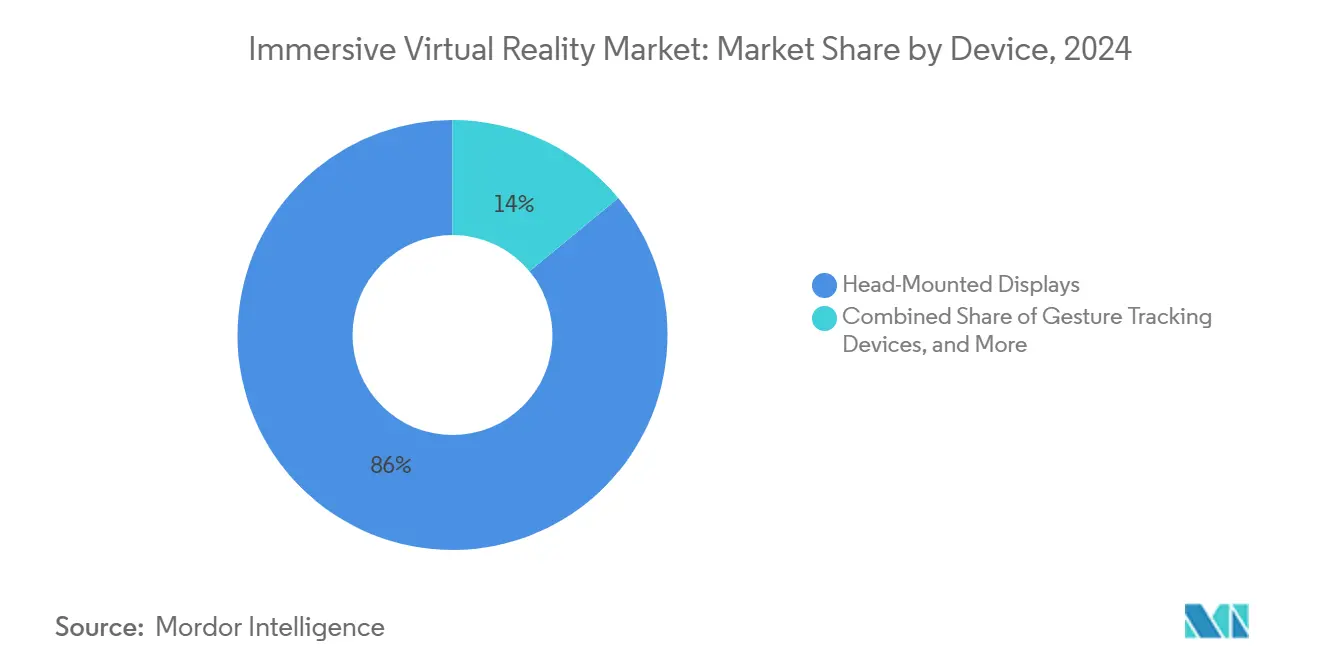
Note: Segment shares of all individual segments available upon report purchase
By End-User Industry: Healthcare Surges on Regulatory Tailwinds
Entertainment and gaming retained a 46% share of the immersive virtual reality market size during 2024 as blockbuster titles and esports events anchored consumer spend. Healthcare, however, is tracking the steepest ascent, estimated to deliver a 29.42% CAGR through 2030 on the back of FDA and CE approvals that open reimbursement lanes. RelieVRx and DeepWell DTx clearances usher therapeutic content into pain management and mental health, shifting the segment from experimental to prescription territory.
Defense and aerospace continue to procure large simulator fleets, evidenced by 225 USAF training units already fielded, while education providers join the vanguard as Walmart, Boeing, and Bank of America quantify double-digit productivity lifts. Automotive firms like Lufthansa and CAE apply mixed reality to crew guidance and cockpit familiarization, and architecture studios leverage holographic walkthroughs to identify design flaws early. Retail engagement remains exploratory, held back by content costs and headset hygiene concerns. Manufacturing and energy majors such as BP roll out safety modules, demonstrating how healthcare’s validation effect is permeating adjacent sectors, which amplifies growth momentum for the immersive virtual reality market.
By Component: Software Outpaces Hardware Maturity
Hardware still commands 86% revenue in 2024, yet software is expanding at a 29% CAGR as enterprises redirect budgets toward custom applications and analytics dashboards. Apple Vision Pro’s USD 1,542 component tally highlights the capital intensity required for micro-OLED and sensor stacks, explaining why vendors are racing to reduce optics prices. Samsung entered the fray in late 2024 with a Snapdragon XR2+ Gen 2-powered device but capped first-run volumes at 300,000 units due to supply constraints.
Software suppliers benefit from recurring license fees and faster release cycles unhampered by physical inventory. Device-management platforms such as ArborXR oversee more than 3,000 enterprise deployments, simplifying fleet updates and compliance reporting. Cloud-rendered streaming builds a thin-client paradigm that shifts compute overhead to the edge, helping buyers defer headset upgrades. AI accelerates content production through procedural world-building and adaptive learning scripts. Services revenues scale in tandem, covering systems integration and regulatory validation. As hardware shortages ease post-2026, balanced growth across components is expected to reinforce the immersive virtual reality market.
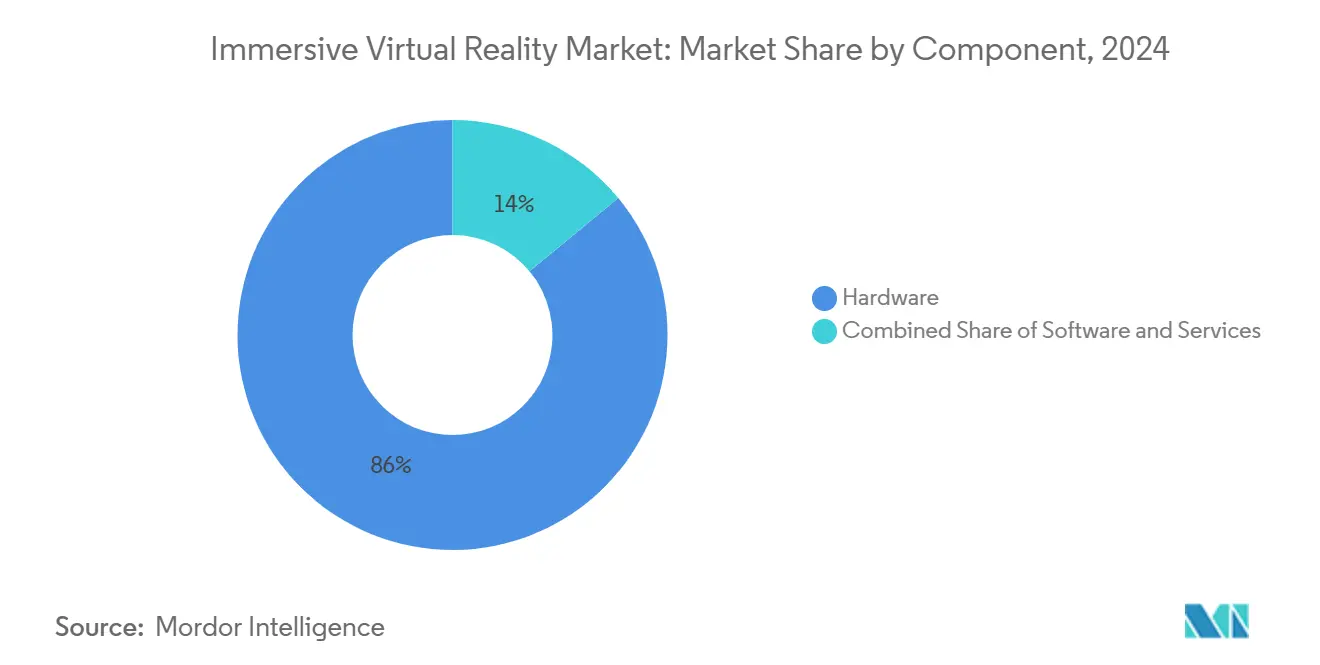
Note: Segment shares of all individual segments available upon report purchase
By Immersion Type: Fully-Immersive Formats Sustain Lead
Fully-immersive environments accounted for 62% of 2024 revenue and are slated to climb at 31.34% CAGR as organizations favor total sensory isolation for high-risk simulation and therapeutic focus. Military pilots rely on panoramic displays and motion platforms that mirror G-force cues, while FDA-approved pain therapy depends on uninterrupted visual immersion to modulate neural pathways.
Semi-immersive solutions appeal to industrial training where some real-world awareness is required for safety, yet their share is flattening as hardware costs fall, and full immersion becomes affordable. Non-immersive desktop VR is declining as users migrate to head-mounted options with richer presence cues. Chinese culture parks showcase fully immersive story arcs blending scent, haptics, and volumetric capture, encouraging prolonged engagement. AI-enhanced motion prediction curbs cybersickness, addressing a lingering adoption hurdle. Cost inflation still affects fully-immersive systems more heavily due to multi-display rigs, but modular designs and cloud offloading are expected to narrow the gap, sustaining leadership for the immersive virtual reality market.
Geography Analysis
North America continued to lead the immersive virtual reality market with 38% revenue share in 2024, buoyed by substantial defense spending and early enterprise adoption. U.S. companies benefit from large pilot training budgets and healthcare reimbursement pipelines, although higher semiconductor fabrication costs raise hardware prices relative to Asian competitors. The region is leveraging cloud infrastructure and 5G roll-out to pilot remote rendering solutions that could offset device cost barriers. Corporate training programs at Walmart, Boeing, and Bank of America supply domestic proof points, reinforcing vendor focus on North American clients.
Asia Pacific registered the highest regional CAGR at 32.60%, propelled by China’s structured metaverse policy framework and more than 100 large-scale VR installations commissioned in 2024. The Ministry of Industry and Information Technology formed a standards committee that aligns device protocols, while the National Film Administration encouraged VR cinema roll-outs. IDC projects regional AR/VR spending to surpass USD 10.5 billion by 2029, equal to 26.5% of global outlays. Japan and South Korea add momentum through government grants for education and smart-manufacturing pilots, and India’s cost-efficient developer pool accelerates localized content creation. Proximity to component supply chains helps mitigate freight delays, though natural disaster risks such as TSMC’s earthquake and typhoon-driven quartz disruptions remain operational concerns.
Europe holds a strategic middle position, supported by the European Commission’s virtual worlds roadmap and Germany’s XR-Interaction network of 60 firms receiving multi-year state funding. The Virtual and Augmented Reality Industrial Coalition forecasts 860,000 new European jobs by 2025, signaling political will to compete with U.S. and Chinese ecosystems. The London School of Economics champions an “Airbus for the metaverse” to pool industrial expertise, while companies such as BMW, IKEA, and Bosch experiment with interoperable digital twins. Currency fluctuations and stricter privacy rules can slow consumer uptake, yet cross-border collaboration on standards and ethics enhances long-term regional competitiveness, sustaining European contribution to the immersive virtual reality market.
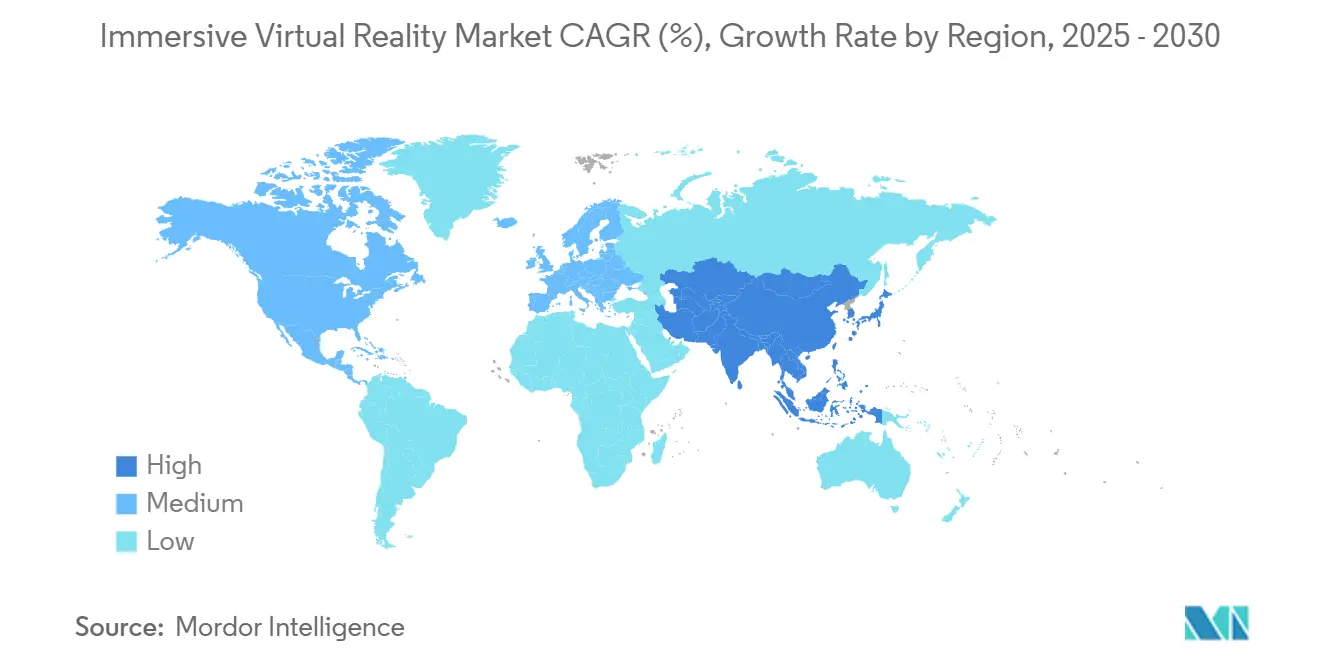
Competitive Landscape
Market concentration is moderate as global technology leaders hold meaningful share, while specialized firms carve out vertical niches. Meta commands roughly 73% of head-set shipments through its Quest family, but Reality Labs continues to post heavy operating losses, surpassing USD 58 billion cumulatively since 2020. Apple’s Vision Pro captured 5% share within months, validating a premium productivity-and-healthcare orientation despite its elevated retail price[1]Apple Inc., “Introducing Vision Pro,” apple.com. Sony maintains a 9% presence through PlayStation VR2; however, shipment volume softened 25% in 2024 as consumers sought broader use cases beyond gaming.
Strategic partnerships underscore enterprise value. Microsoft and Meta co-develop workplace avatars via Mesh, while defense integrators Lockheed Martin and Red 6 incorporate AR overlays into trainer jets for the U.S. Air Force and Navy. Vrgineers collaborates on F-35 simulators, and Vertex Solutions supports FAA standard updates, cementing defense and aviation influence over feature roadmaps. RelieVRx and DeepWell DTx exemplify medical verticalization, obtaining regulatory clearance for pain and mental-health therapies that few broad-platform vendors pursue.
Mergers and acquisitions hint at consolidation: Google purchased part of HTC’s XR unit for USD 250 million to strengthen Android XR, and Infinite Reality acquired Landvault and The Drone Racing League in deals totalling USD 700 million to scale metaverse entertainment. Samsung, Qualcomm, and Qualcomm’s foundry partners are pushing chipset roadmaps that optimize AI inference on-device, reducing dependence on discrete GPUs and lowering bill of materials. Supply chain fragility remains a shared pain point, as quartz mine outages and tariff escalations pose price-eco-system risks but also encourage regional diversification. Overall, competitive positioning is fluid, yet sustained R&D and policy backing are likely to preserve a balanced landscape for the immersive virtual reality market.
Immersive Virtual Reality Industry Leaders
-
Carl Zeiss AG
-
Sony Corporation
-
EON Reality
-
Avegant Corporation
-
Samsung Electronics Co., Ltd.
- *Disclaimer: Major Players sorted in no particular order

Recent Industry Developments
- January 2025: Google acquired part of HTC’s extended reality unit for USD 250 million to speed Android XR platform development.
- January 2025: Infinite Reality secured USD 3 billion funding, lifting its valuation to USD 12.25 billion after buying Landvault and The Drone Racing League.
- January 2025: Aonic completed a USD 110 million purchase of nDreams, expanding its footprint in VR and MR gaming.
- December 2024: Samsung began production of an XR headset powered by Snapdragon XR2+ Gen 2, initial price around USD 2,000, with first-run volumes capped at 300,000 units.
Global Immersive Virtual Reality Market Report Scope
Immersive virtual reality involves the creation of simulated environments that imitate real objects or people to create an illusion. The creation of such an illusion helps people understand the actual environments of an industry, arena, space, or situation.Immersive virtual reality has applications across a wide array of industries, such as gaming and entertainment, defense, and healthcare, which are projected to bring in key revenues to the global market. The VR market for software includes apps, platforms, and content providers in the VR space.
The market sizes and forecasts are provided in terms of value (USD million) for all the above segments.
| Head-Mounted Displays (HMDs) | Stand-alone HMDs |
| Tethered HMDs | |
| Smartphone-based HMDs | |
| Gesture Tracking Devices | Haptic Gloves |
| Motion Controllers | |
| Full-Body Suits | |
| Haptic Feedback Devices | |
| VR Cameras |
| Entertainment and Gaming | |
| Aerospace and Defence | |
| Healthcare | Surgery and Medical Training |
| Rehabilitation Therapy | |
| Mental Health and Pain Management | |
| Education and Training | |
| Automotive and Transportation | |
| Architecture, Engineering and Construction (AEC) | |
| Retail and E-commerce | |
| Other Industries |
| Hardware |
| Software |
| Services |
| Fully-Immersive |
| Semi-Immersive |
| Non-Immersive |
| North America | United States |
| Canada | |
| Mexico | |
| South America | Brazil |
| Argentina | |
| Rest of South America | |
| Europe | United Kingdom |
| Germany | |
| France | |
| Italy | |
| Spain | |
| Rest of Europe | |
| Asia-Pacific | China |
| Japan | |
| South Korea | |
| India | |
| Rest of Asia-Pacific | |
| Middle East | United Arab Emirates |
| Saudi Arabia | |
| Turkey | |
| Rest of Middle East | |
| Africa | South Africa |
| Nigeria | |
| Kenya | |
| Rest of Africa |
| By Device | Head-Mounted Displays (HMDs) | Stand-alone HMDs |
| Tethered HMDs | ||
| Smartphone-based HMDs | ||
| Gesture Tracking Devices | Haptic Gloves | |
| Motion Controllers | ||
| Full-Body Suits | ||
| Haptic Feedback Devices | ||
| VR Cameras | ||
| By End-user Industry | Entertainment and Gaming | |
| Aerospace and Defence | ||
| Healthcare | Surgery and Medical Training | |
| Rehabilitation Therapy | ||
| Mental Health and Pain Management | ||
| Education and Training | ||
| Automotive and Transportation | ||
| Architecture, Engineering and Construction (AEC) | ||
| Retail and E-commerce | ||
| Other Industries | ||
| By Component | Hardware | |
| Software | ||
| Services | ||
| By Immersion Type | Fully-Immersive | |
| Semi-Immersive | ||
| Non-Immersive | ||
| By Geography | North America | United States |
| Canada | ||
| Mexico | ||
| South America | Brazil | |
| Argentina | ||
| Rest of South America | ||
| Europe | United Kingdom | |
| Germany | ||
| France | ||
| Italy | ||
| Spain | ||
| Rest of Europe | ||
| Asia-Pacific | China | |
| Japan | ||
| South Korea | ||
| India | ||
| Rest of Asia-Pacific | ||
| Middle East | United Arab Emirates | |
| Saudi Arabia | ||
| Turkey | ||
| Rest of Middle East | ||
| Africa | South Africa | |
| Nigeria | ||
| Kenya | ||
| Rest of Africa | ||
Key Questions Answered in the Report
What is the current size of the immersive virtual reality market?
The market is valued at USD 12.75 billion in 2025 and is projected to reach USD 41.45 billion by 2030, growing at a 28.22% CAGR.
Which device category leads the immersive virtual reality market?
Head-mounted displays remain dominant, holding 86% revenue share in 2024, while stand-alone models are growing at more than 33% CAGR.
Why is healthcare considered the fastest-growing end-user segment?
FDA and CE approvals for therapies such as RelieVRx and DeepWell DTx have unlocked reimbursement pathways, accelerating a 29.42% CAGR for healthcare applications through 2030.
Which region is expanding fastest in immersive virtual reality adoption?
Asia Pacific is advancing at a 32.60% CAGR due to Chinese government support and extensive location-based VR installations.
What are the main restraints hindering market growth?
High ownership costs for advanced rigs and a limited content ecosystem slow near-term adoption, trimming CAGR by an estimated 3.2% and 2.8%, respectively.
How are enterprises measuring ROI from immersive virtual reality deployments?
Savings include a 96%-time reduction in Walmart retail training and 75% efficiency gains in Boeing engineering programs, demonstrating rapid payback periods for large-scale roll-outs.
Page last updated on:
